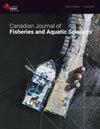将理想自由分布应用于高度流动的太平洋鲑鱼刺网捕鱼活动
IF 2.2
2区 农林科学
Q2 FISHERIES
Canadian Journal of Fisheries and Aquatic Sciences
Pub Date : 2023-11-28
DOI:10.1139/cjfas-2023-0134
引用次数: 0
摘要
生态模型用于了解渔船的作业地点,从而提高渔业管理的成功率。理想自由分布(IFD)预测不同地点的渔获量会因鱼类和竞争船只的分布而均衡。我们将 IFD 作为一个空模型,研究了 1980-2019 年期间阿拉斯加州布里斯托尔湾红鲑流刺网船队的移动和每船渔获量(CPUE)。IFD 预测的各地区 CPUE 相等的结论未得到支持,因此我们探讨了违反该理论两个假设的情况。我们根据每艘渔船的移动性对其进行分类,强调 "自由移动 "假设,并发现当我们剔除非移动渔船时,一些地区的渔船数量比高 CPUE 预测的要少。我们通过计算相对于其他渔船的平均渔获量,检验了 "同等竞争能力 "假设。盈利区利用不足的情况依然存在。总体而言,考虑到流动性和相对捕捞成功率的差异,船队对高 CPUE 区域的利用率较低,这表明未衡量的安全问题、旅行成本、对渔场的了解或其他因素可能会阻碍 IFD 的实现。本文章由计算机程序翻译,如有差异,请以英文原文为准。
Applying the Ideal Free Distribution to the movement of a highly mobile gillnet fishery for Pacific salmon
Ecological models are used to understand where fishing vessels operate, improving fisheries management success. The Ideal Free Distribution (IFD) predicts equalization of catch across locations in response to distributions of fish and competing vessels. We applied the IFD as a null model to investigate the movement and catch per vessel (CPUE) of the sockeye salmon drift gillnet fleet in Bristol Bay, AK, from 1980-2019. The IFD prediction of equal CPUE across areas was not supported, so we explored violations of two assumptions of the theory. We categorized each vessel according to its mobility, highlighting the “free to move” assumption, and found when we removed nonmobile vessels, some districts had fewer vessels than predicted from their high CPUE. We examined the “equal competitive ability” assumption by calculating the average CPUE, relative to success of other vessels. The underutilization of profitable districts persisted. Overall, the fleet underused high CPUE areas when considering differences in mobility and relative fishing success, indicating unmeasured safety concerns, travel costs, knowledge of fishing grounds, or other factors could be preventing an IFD.
求助全文
通过发布文献求助,成功后即可免费获取论文全文。
去求助
来源期刊

Canadian Journal of Fisheries and Aquatic Sciences
农林科学-海洋与淡水生物学
CiteScore
4.60
自引率
12.50%
发文量
148
审稿时长
6-16 weeks
期刊介绍:
The Canadian Journal of Fisheries and Aquatic Sciences is the primary publishing vehicle for the multidisciplinary field of aquatic sciences. It publishes perspectives (syntheses, critiques, and re-evaluations), discussions (comments and replies), articles, and rapid communications, relating to current research on -omics, cells, organisms, populations, ecosystems, or processes that affect aquatic systems. The journal seeks to amplify, modify, question, or redirect accumulated knowledge in the field of fisheries and aquatic science.
 求助内容:
求助内容: 应助结果提醒方式:
应助结果提醒方式:


